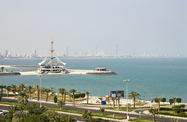Despite falling oil prices, the economy in Qatar maintained a steady rate of expansion throughout 2014, with targets of even more robust growth this year, fuelled by the non-hydrocarbon sector.
Qatar, the world’s largest exporter of liquefied natural gas (LNG) and one of the smaller oil producing countries, estimates the non-hydrocarbons share of GDP will overtake that of oil and gas in 2015. According to official figures in December, GDP is forecast to grow by 7.7% in 2015, compared with a projected 6.3% in 2014. The Ministry of Development Planning and Statistics said that the overall fiscal balance is expected to stay in surplus in 2015, though it is set to narrow as public spending gathers pace. Domestic risks to the economy are centred around the scale and complexity of Qatar's planned infrastructure projects before it hosts the 2022 FIFA World Cup football tournament, the ministry said.
However, investors across the region have taken flight over a gloomy outlook for oil prices in 2015, with the Qatar Exchange slumping in the fourth quarter and early January, after posting strong growth in the first three quarters of 2014.
Gas over oil
Qatar may feel less pain than most other major producers due to its focus on gas over oil in terms of export commodities. With much of its liquefied natural gas (LNG) exports locked in by long-term contracts, it is less vulnerable to market fluctuations; nonetheless, historically gas prices lag oil prices by six months. An additional factor supporting earnings is that most of its LNG output is shipped to Asia, which is still expected to post solid growth in 2015, thereby maintaining demand for energy.
With the price of Brent crude plunging from a mid-year high of $115 to below $50 at the start of January, the finances of energy exporters around the world are under pressure. At the end of December, credit ratings agency Moody’s put Qatar’s break-even oil price at $59, one of the lowest of any major producer while its budget this year is based on an assumed an oil price of $65.
In spite of the non-hydrocarbon sector being the primary driver of growth in recent years, hydrocarbon receipts generated about 86% of the government's revenues in 2013 and have been largely responsible for Qatar’s fiscal surpluses, according to the report. Moody’s added that oil prices could become a key risk to the economic outlook if their slide continued, but noted that the wider economy was likely to be shielded by the strength of state finances.
Infrastructure boom
Ongoing investments in infrastructure are providing further stimulus. Some of these are related to hosting the 2022 World Cup, while others are being driven by increased spending on transport and logistics. Just under $27bn worth of large-scale infrastructure projects were awarded in 2014, according to a Standard Chartered report, a figure that is set to rise to around $34bn in the coming year, as Qatar moves to meet its expanding social and economic needs.
While these investments will support growth in the construction sector, the growing pace of development is putting upward pressure on both building costs and the price of land, which was 73% higher year-on-year as of October. Much of this increase in construction activity was due to the sharp rise in population during 2014, which expanded by some 10% – a result of both natural growth and an influx of foreign workers to support new projects.
Although greater demand for housing and services, along with rising land and materials costs, will seep into the consumer price index (CPI), inflation remained steady in 2014, running at an annualised 3.6% at the end of the third quarter. However, this could rise, as increases in rental and accommodation costs, which have a significant weight in the CPI, have witnessed upward movement in the final months of the year.
Strong fiscal fundamentals
The state is also taking steps to reduce borrowing and pay down debt. Public loan levels fell 6% in the year-to-date in early December, according to a Morgan Stanley report, while total system loans were up 9%, the slowest rate in nearly four years. Despite the slowing of public borrowing, the report forecast private loan growth to continue at a strong pace, in the 10-20% range, with corporate credit demand to remain elevated. As of December, almost 60% of domestic loans held by Qatari banks were taken out by the private sector, up from 55% the year before.
Much of this private borrowing has been used to fund investments and growth in the non-oil and non-state sectors of the economy. As of early December, private sector growth in 2014 was expected to top the 11% seen in 2013 and nearly double the rate of GDP expansion, according to the prime minister, Sheikh Abdullah bin Nasser bin Khalifa Al Thani. Nonetheless, a recent report by the IMF noted that banks in the GCC will struggle to diversify their credit portfolios due to the dependence of the non-oil sector on the hydrocarbons segment, with banks’ net income highly correlated to oil-driven fiscal developments.
Higher domestic demand and relatively steadier energy earnings should see Qatar’s economy maintain solid growth into 2015, as private sector activity continues to expand and state-funded investments broaden the base of economic development.

